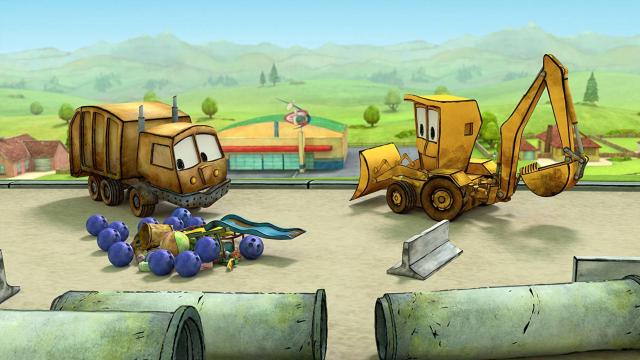There’s a problem in the city. A dump truck has dropped her bin full of bowling balls all over the street without realising it — the balls that were supposed to be delivered to the bowling alley. Stinky, a garbage truck, and Dirty, a backhoe loader, see it happen and decide they will get the balls to the destination themselves. But how?
They try different strategies. What if they lifted each one into Stinky’s bin? (It would take forever.) What if they rolled them in there? (That would work, but the truck would then be too heavy to move.) What if they pushed the balls there? (Hmm, now we’re getting somewhere.) What if they put them into a giant nest so that a massive bird will think they’re her eggs and transport them in her mouth? (Ummmm, let’s go back to brainstorming.)
What if?
It’s the question continually pondered in The Stinky & Dirty Show, an Amazon original preschool series that releases its newest half-season this week.
The show, based on the I Stink book series by Kate and Jim McMullan, is stunningly drawn and has an irresistible premise (Trucks? Being filthy? What’s not to love?), but beyond that, it delivers an important message that kids need to hear again and again — that it’s OK to fail.
“‘What if?’ is sort of the genesis of hope,” says Jessica Lahey, who helped develop the series’ curriculum. “‘What if?’ is the genesis of creativity and ‘what if?’ is always the genesis of resilience.”
The lessons of The Stinky & Dirty Show align with the research behind Lahey’s bestselling book The Gift of Failure: How the Best Parents Learn to Let Go So Their Children Can Succeed. In each episode, best friends Stinky and Dirty start with a problem that they have no idea how to solve, and eventually work it through — by talking to each other, by drawing out potential solutions, and by trying, messing up and trying again.
“It’s very much linked to design thinking,” says Lahey, referring to the method of solving problems by experimentation rather than by relying on what’s worked in the past.
As Stinky and Dirty attempt other ways of getting the bowling balls to the alley, a song plays in the background: “You can do it. You can do it. So what if it ain’t been done before? Try, try, try just a little more.”
How they finally get the job done in the end is by building a life-sized marble run out of pipes and concrete blockades, and then rallying the community to help.
As a parent always looking for smart, thoughtful children’s media to show my five-year-old, I dig The Stinky & Dirty Show. In the new season, there are bigger dilemmas that the characters must face — how to get through slow moving traffic jam with a lot of crabby vehicles, how to remember the list of items they’re supposed to bring to a construction site, how to help a buoy who’s afraid of being on land.
Lahey says the team created the show in a way to spark family conversations. Here are some ways you can help your kids live out the show’s lessons their everyday worlds:
- Use the power of “What if?” to help them change how they view themselves. “I teach at a drug and alcohol rehab,” Lahey says. “So I teach kids who have never really had people believe in them. So a lot of times, they’ll come to me and say, ‘Well I can’t do that because blah blah blah,’ and I’ll say, ‘Well, let’s just pretend for a minute that you can. Let’s use our creativity and say: I am capable of doing this thing now. What if you believed that? What would that look like?’”
-
Stop giving them the answers. Lahey says our job as parents is to talk through the options with kids — not to give them the answers. For example, getting out of the house in the morning can be frustrating for everyone. As you’re leaving the house, instead of telling kids, “Hey, you forgot your backpack, lunch and jacket. Go back and get them,” you can share strategies that you’ve picked up over the years.
Says Lahey: “You might say to them, ‘You know, before I leave the house in the morning, I like to think about all the things I need and do a little checklist.” Then they can come up with their own solutions.
-
Let them mess up. Lahey believes mistakes are where “the best learning happens”. And there will always be new problems.
“I’ve started driving around, thinking about Stinky & Dirty and different types of scenarios they might get into,” she says. “Like, what if they have to get water up to a water tower? How would they do that? Or what if they’ve got to get the water into a fire truck? How would they do that? It’s been so fun to brainstorm. I love it.”

Comments